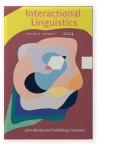Vol. 4:1 (2024) ► pp.97–129
Escalating prosody
The vocal depiction of mobile action sequences
This paper shows how horse-riding instructors vocally depict, and thereby co-design and mobilize the unfolding progression of horses’ and riders’ actions through gradually escalating prosody. Escalating prosody involves the stepwise raising of a speaker’s overall pitch across a series of turn components, often accompanied by increases in overall loudness and occasionally by changes in voice quality. Escalating prosody can accompany instructed activities from beginning to end or only during certain phases of the activity. The prosodic delivery mirrors the building and subsequent sustaining of physical effort expected of the horse-rider pair. It can occur with lexical instructions to perform series of actions or with repeated directives to sustain the current activity. It can also occur with repeated praise as a successful performance unfolds, and with repeated corrections, which temporally frame moments of trouble. Prosody is shown to be a resource for co-designing the actions of others, specifically, their mobility, physical effort, and sequential progression. The data are horse-riding lessons recorded in the UK and in Germany.
Article outline
- 1.Introduction
- 2.Sound patterns in instruction sequences
- 3.Intensified prosodic delivery
- 4.Data
- 5.An interactionalist approach to horse-riding lessons
- 6.Escalating prosody: depicting the mobile activities of others
- 6.1Instructing to-be-sustained activities
- 6.2Unfolding praise
- 6.3Escalating corrections
- 7.Discussion
- Notes
-
References
